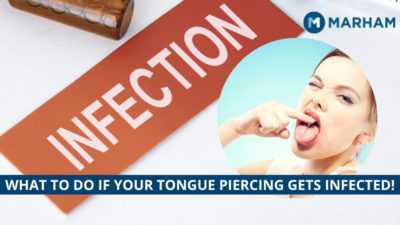Imagine getting a mouth piercing, then a few days later, you don’t feel like eating or talking. You may be wondering if your tongue piercing is infected, or if it’s all in your head.
This health blog is all about Infected Tongue Piercing and will cover all questions asked about tongue piercing infections. So, if you want advice on what you can do about your condition keep on reading.
What are the Signs of an Infected Tongue Piercing?
Some common signs and symptoms of an infected tongue piercing are:
- Swelling: If your tongue is so swollen that you’re having trouble eating or talking, it might be an infection. Your tongue should not be so swollen that you can’t breathe. If this is the case, get to a doctor or hospital right away.
- Tenderness and redness: Keep an eye out for redness and soreness that lasts more than a week, as well as crimson streaks coming out of the piercing. Tenderness should progressively disappear by the time your tongue piercing is healed if your piercing is healthy.
- Bleeding or discharge: While healing, your tongue may bleed or leak fluids. That is not a reason for concern. However, yellow or green pus is never a healthy indication.
Some other common symptoms of infected tongue piercing can be:
- persistent warmth
- severe pain
- excessive bleeding
- bump at the front or back of the piercing
- fever
If you have any of these symptoms after getting a piercing, consult with a doctor as soon as possible. Click here to talk to an online doctor now via Marham.
What are the Causes of Infected Tongue Piercing?
While bacterial infections following tongue piercing are rare, there are reports of potentially life-threatening infections associated with the procedure. –Bacterial infections complicating tongue piercing
A tongue-piercing infection is caused by the accumulation of dangerous germs in the piercing incision. These germs cause your body to react with a number of unpleasant symptoms.
When microorganisms become trapped inside the piercing wound, infections are more prone to arise. Because your mouth contains so many germs, tongue piercings are far more prone to infection than other piercings.


Here are four common reasons people get tongue piercing infections are:
1. Poor oral hygiene
The excess bacteria in your mouth is removed by brushing, flossing, and using mouthwash. So, whether you have oral piercings or not, good dental health is essential. It’s much more vital if you have a tongue piercing, especially if it’s healing.
Avoiding excessively sugary foods and drinks is another way to prevent extra germs and inflammation in the mouth.
2. Weak Immune System
You may not know it, but the health of your mouth is linked to the overall immune system of your body. If you do not take care of yourself, your oral health will suffer as a result. Therefore, you should have a healthy diet that includes foods rich in Vitamin C. A healthy body is better equipped to prevent and fight infections, such as tongue piercing infections.
3. Dirty Piercing Situations
Bacteria can enter your piercing if you get it at a piercing studio that is unclean. As studios continue to learn and adopt the best procedures for sterilizing equipment and avoiding infection, this is becoming less typical.
4. Touching your tongue
If you meddle with your tongue with unclean hands, you’re transferring bacteria directly onto your piercing and risking illness. Therefore, you should avoid touching it at all costs.
Also, read about Infected Ear Piercings
How can you Prevent Tongue Piercing Infections?
According to the American Dental Association, to prevent getting an infection after piercing your tongue you must do the following:
Use a mouthwash or rinsing solution:
To reduce the risk of infection in the days and weeks following a tongue piercing, clean the piercing site with a mouth rinse. During and after the healing phase, wash your mouth with an alcohol-free mouth rinse on a frequent basis.
Be extra careful while eating
Use your fingers to place food straight on your molars for chewing to prevent food from contacting the piercing during the healing time. Just make sure to properly wash your hands with antibacterial soap before putting them in your mouth.
Use a soft-bristled toothbrush:
Using a fresh toothbrush after a piercing helps to prevent the introduction of new bacteria into the mouth. After receiving a tongue piercing, the ideal toothbrush to use is one with soft bristles that can reach into tight spaces without being harsh on the region.
By using these safety precautions you can prevent getting an infection at your piercing site.
What is the Treatment of Infected Tongue Piercing?
If you catch an infection early on, you can try to treat it at home. Simply keep an eye on your symptoms to ensure they don’t worsen.
However, if you have a serious or long-lasting infection, you should see a doctor for antibiotic therapy. It will keep more significant issues at bay.
Can’t Find the App?
| Android | IOS |
|---|---|
  |
  |
FAQs
How do I know if my tongue piercing is infected?
You can identify a tongue-piercing infection if you have an extremely swollen tongue, redness, tenderness, discoloration, excessive bleeding, or a bump on your tongue. See your doctor as soon as possible after you notice any of these.
How long does it take for an infected tongue to heal?
A painful tongue is typically not dangerous and will go away on its own within two weeks. Meanwhile, you might attempt a few home treatments to alleviate pain for example using a cold compress.
How easily do tongue piercings get infected?
Due to the microorganisms in our mouth, tongue piercings, especially fresh ones, are more prone to infection than other piercings. Eating, drinking and involving in sexual activity can also introduce a lot of microorganisms.

